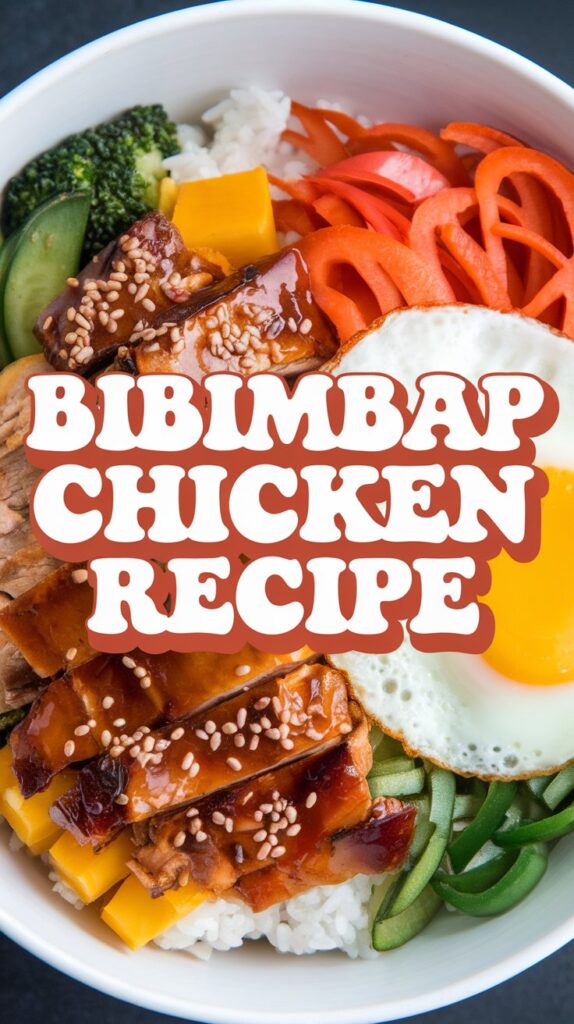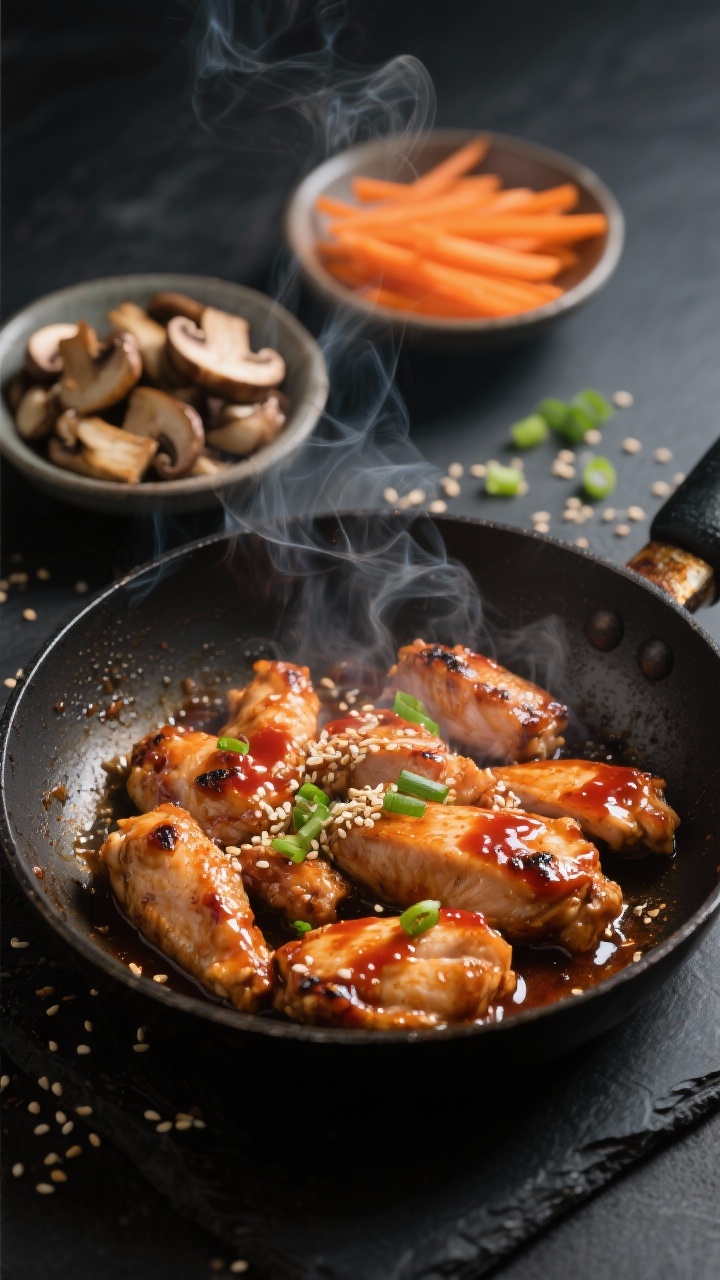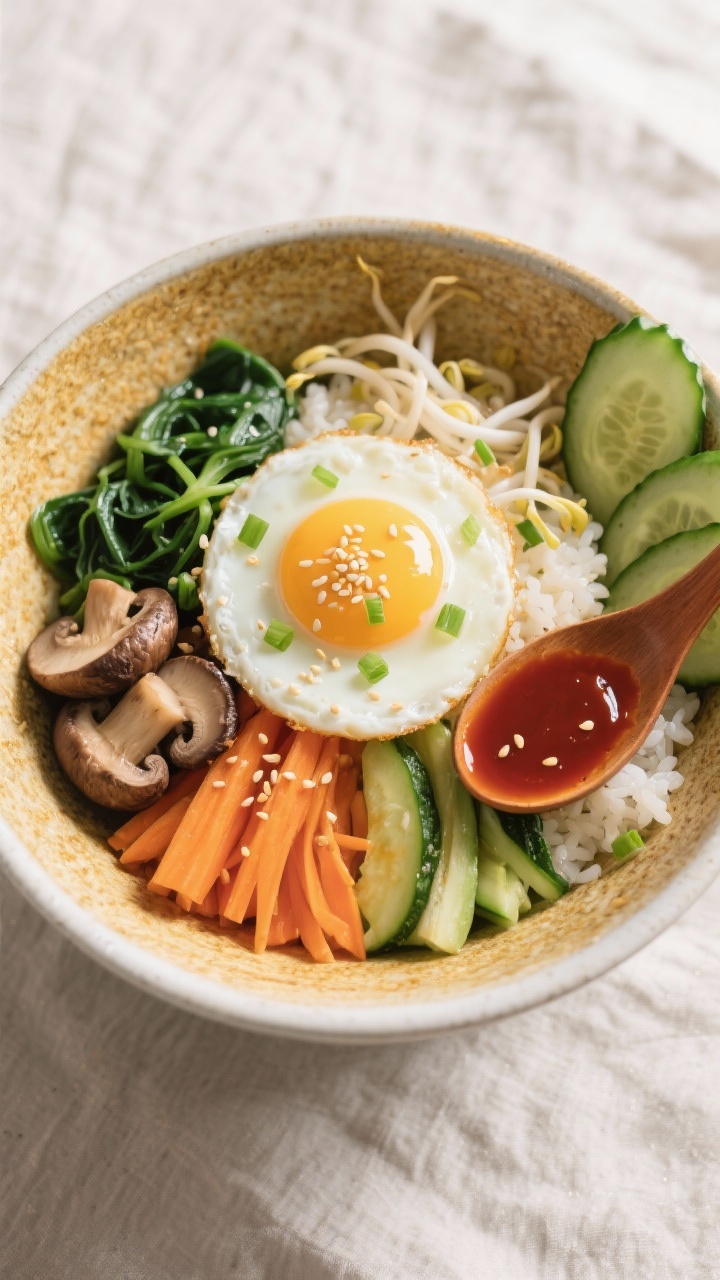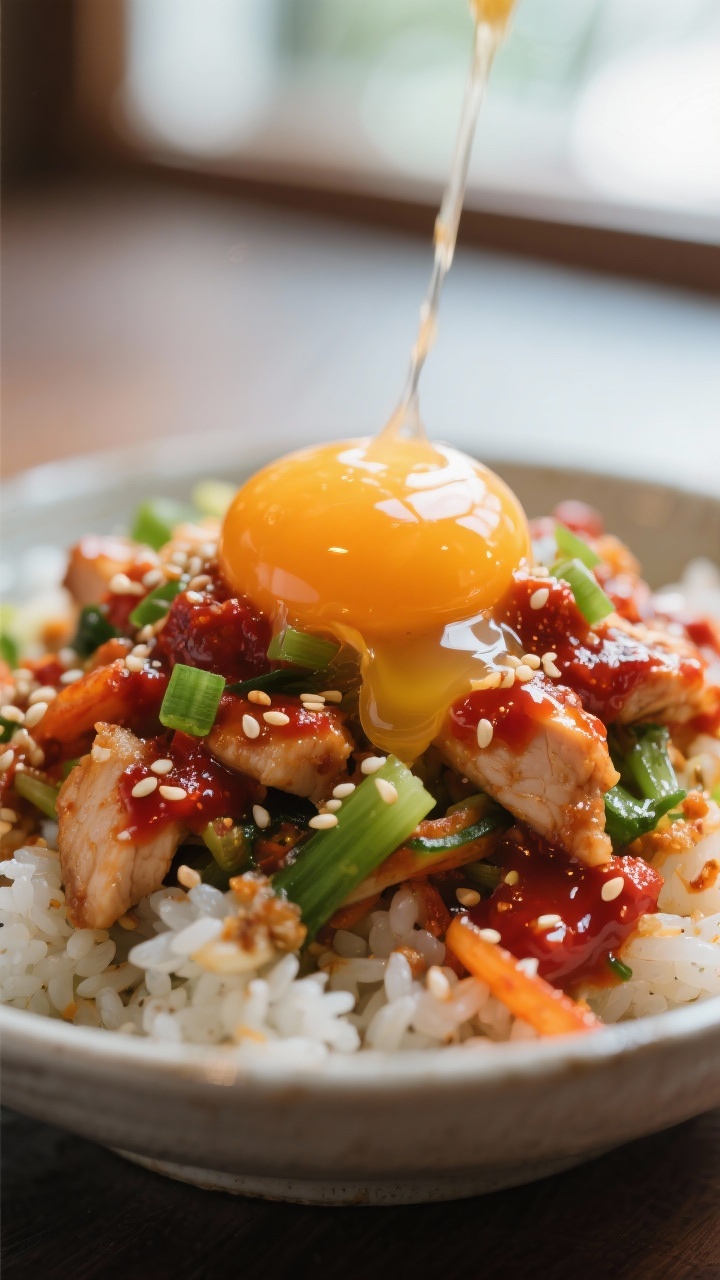
Picture a bowl that hits sweet, salty, spicy, crunchy, and umami in one bite, then puts a runny egg on top like a mic drop. That’s bibimbap with chicken: fast, flexible, and ridiculously satisfying. No fancy chef skills, no obscure gear just sizzling chicken, caramelized veggies, and a sauce that makes takeout taste like a compromise.
You want a crowd-pleaser? This is it. And yes, it’s meal-prep friendly, wallet-friendly, and flavor maximalist.
The Secret Behind This Recipe

Everyone thinks bibimbap is about the toppings.
It is—but the real flex is balance. We’re building layers: savory chicken, crisp-tender veggies, fragrant rice, and a glossy, spicy-sweet gochujang sauce that ties everything together. When each component gets its moment (properly seasoned and cooked separately), the final bowl hits like a K‑pop hook.
The other secret? Texture contrast. You’ll get chew from rice, crunch from veggies, tender chicken, and that iconic egg on top.
Pro tip: a quick sesame oil finish and lightly charred rice at the bottom take it from “pretty good” to “where has this been all my life?”
Shopping List – Ingredients
- Cooked rice (3–4 cups; short-grain or jasmine; day-old is best)
- Chicken (1 lb; boneless, skinless thighs preferred, or breasts thinly sliced)
- Gochujang (Korean red chili paste; 3 tbsp)
- Soy sauce (low-sodium; 3–4 tbsp total)
- Sesame oil (2–3 tbsp)
- Rice vinegar (1–2 tbsp)
- Honey or brown sugar (1–2 tbsp)
- Garlic (3–4 cloves, minced)
- Ginger (1 tbsp, minced or grated)
- Vegetables:
- Carrots (2, julienned)
- Zucchini (1–2, julienned)
- Spinach (4 cups fresh)
- Bean sprouts (1–2 cups, optional)
- Shiitake or cremini mushrooms (1 cup, sliced)
- Cucumber (1, thinly sliced, optional for freshness)
- Eggs (2–4, for serving; sunny-side up or fried)
- Green onions (2–3, sliced)
- Sesame seeds (1–2 tsp, toasted)
- Neutral oil (avocado, canola, or grapeseed for high heat)
- Optional heat boosters: gochugaru (Korean chili flakes), sriracha
- Salt and pepper to taste
Instructions

- Make the sauce. In a small bowl, whisk 3 tbsp gochujang, 1.5 tbsp soy sauce, 1 tbsp honey, 1 tsp sesame oil, 1 tsp rice vinegar, and half the garlic and ginger. Adjust the heat with gochugaru if you like it spicy. Set aside—it’s the glue of the bowl.
- Marinate the chicken. Toss sliced chicken with 2 tbsp soy sauce, 1 tsp sesame oil, the remaining garlic and ginger, and a pinch of pepper.
Let it sit 10–20 minutes while you prep veggies. No, you don’t need an overnight marinade; we’re cooking hot and fast.
- Prep the rice. If using day-old rice, break up clumps. If fresh, fluff it and let it steam off a few minutes so it’s not gummy.
Lightly season with a pinch of salt and 1 tsp sesame oil for fragrance.
- Cook the veggies separately. Heat a large skillet or wok over medium-high heat. Add a drizzle of neutral oil and quickly sauté each veggie with a pinch of salt, removing after each to keep colors and textures bright:
- Carrots: 1–2 minutes until just tender.
- Zucchini: 1–2 minutes; don’t let it go mushy.
- Mushrooms: 3–4 minutes until browned; splash soy for umami.
- Bean sprouts: 1 minute, keep them crisp.
- Spinach: 30–60 seconds until wilted; finish with a few drops of sesame oil.
- Cook the chicken. Crank the heat to high, add oil, and sear chicken in a single layer. Don’t crowd the pan.
Cook 5–7 minutes until browned and cooked through. Toss in 1–2 tbsp of the gochujang sauce at the end for a glossy coat.
- Optional crispy rice move. Add a thin layer of rice to a lightly oiled hot skillet and press down for 3–5 minutes to form a golden, crisp bottom. Think “stone bowl” vibes without the stone bowl.
- Fry the eggs. Sunny-side up or over-easy in a bit of oil.
The runny yolk acts like a bonus sauce. Sprinkle with salt and pepper.
- Assemble. Add rice to bowls. Arrange chicken, carrots, zucchini, mushrooms, spinach, and sprouts in sections.
Top with an egg, cucumber slices, green onions, sesame seeds, and a generous spoon of the gochujang sauce. Mix at the table like you mean it.
Storage Instructions
- Fridge: Store rice, chicken, sauce, and veggies separately in airtight containers for up to 4 days. Keep cucumbers and eggs separate; fry eggs fresh.
- Freezer: Chicken and rice freeze well up to 2 months.
Veggies are hit-or-miss; mushrooms and carrots survive, zucchini and spinach not so much.
- Reheat: Skillet > microwave, IMO. Heat rice with a splash of water, rewarm chicken and veggies until hot, then add a fresh egg and sauce.

Health Benefits
- High-protein fuel: Chicken and egg deliver complete proteins for muscle repair and steady energy.
- Fiber and micronutrients: Carrots, spinach, zucchini, and mushrooms bring vitamins A, C, K, folate, and potassium.
- Healthy fats: Sesame oil offers heart-friendly fats and antioxidants—just a little goes a long way.
- Lower-sugar sauce: You control the sweetness vs. store-bought sauces loaded with corn syrup.
- Balanced macros: Carbs from rice, protein from chicken/egg, fats from sesame—satiating without a food coma.
What Not to Do
- Don’t dump-cook the veggies. Crowding leads to steaming and sad, pale vegetables. Sauté in batches.
- Don’t over-sauce the pan. Add sauce at the end of cooking the chicken.
Too early and it burns, turning bitter.
- Don’t skip seasoning each component. A pinch of salt per veggie makes the whole bowl pop.
- Don’t overcook the egg. The yolk is your creamy finisher. Keep it runny unless you absolutely can’t.
- Don’t use wet rice. Excess moisture kills texture. Let fresh rice steam off or use day-old.
Variations You Can Try
- Spicy bulgogi-style chicken: Add 1 tsp gochugaru and 1 tbsp pear or apple puree to the marinade for sweetness and heat.
- Brown rice or quinoa: For more fiber, swap the base.
Adjust the liquid when cooking grains for fluffiness.
- No-egg version: Use a dollop of silken tofu or a drizzle of tahini for creaminess.
- Crispy chicken: Lightly cornstarch the marinated chicken and pan-fry for extra crunch.
- Extra-green bowl: Add edamame, kale, or snap peas for more bite and color.
- Dairy twist: A tiny spoon of Greek yogurt whisked into the sauce mellows heat and adds tang (non-traditional but tasty, FYI).
FAQ
Can I make this without gochujang?
Yes, but the flavor will shift. Mix miso paste, a bit of sriracha, soy sauce, honey, and rice vinegar as a substitute. It won’t be classic, but it’ll still slap.
What’s the best cut of chicken?
Thighs win for juiciness and flavor.
If you use breasts, slice thinly against the grain and don’t overcook—high heat, short time.
Is bibimbap supposed to be mixed?
Absolutely. The name literally means “mixed rice.” Stir everything together so the sauce coats every grain and veggie. Chaos equals delicious.
How do I make it less spicy?
Use less gochujang and more honey and rice vinegar in the sauce.
You can also add a spoonful of mayo or yogurt for a creamy, mild version.
Can I meal prep this?
Totally. Cook rice, chicken, and veggies ahead, store separately, and assemble with a fresh egg. The sauce keeps in the fridge for a week.
Do I need a stone bowl (dolsot)?
Nope.
A hot skillet gives you crispy rice vibes. If you have a dolsot, preheat it gradually and oil well to avoid sticking.
Gluten-free tips?
Use gluten-free soy sauce or tamari and check your gochujang label for wheat. Most other ingredients are naturally gluten-free.
Can I air-fry the chicken?
Yes.
Marinate, then air-fry at 400°F (205°C) for 8–12 minutes, flipping once, until lightly charred and cooked through.
What if I don’t like mushrooms?
Skip them and double up on zucchini or add bell peppers. The bowl is flexible; keep the color and texture variety.
Final Thoughts
Bibimbap recipe chicken is basically a masterclass in controlled chaos: simple parts, cooked right, assembled boldly. Tweak the heat, swap the veggies, and make it yours without watering down the soul of the dish.
Next time dinner feels stale, remember—one bowl, one sauce, and a runny egg can fix a lot of problems. Now go build the bowl you’ll crave tomorrow.
Printable Recipe Card
Want just the essential recipe details without scrolling through the article? Get our printable recipe card with just the ingredients and instructions.


